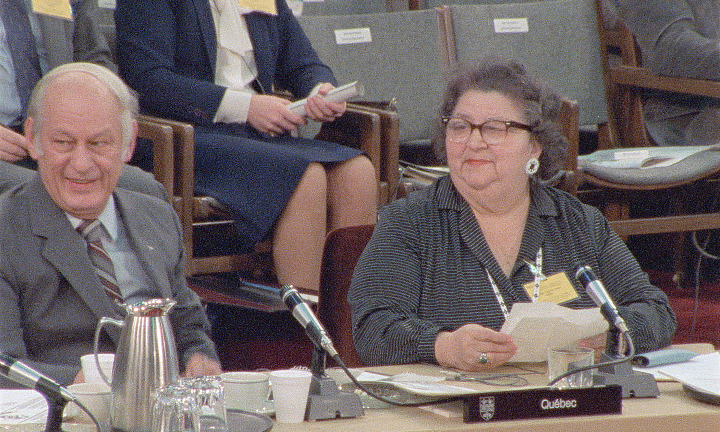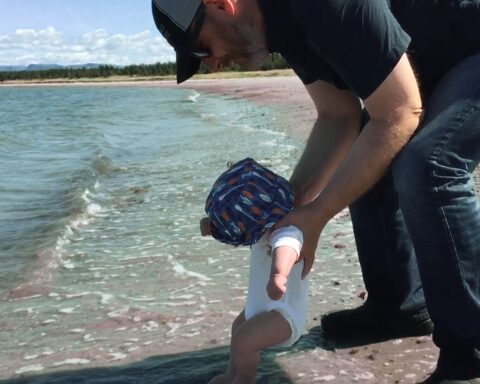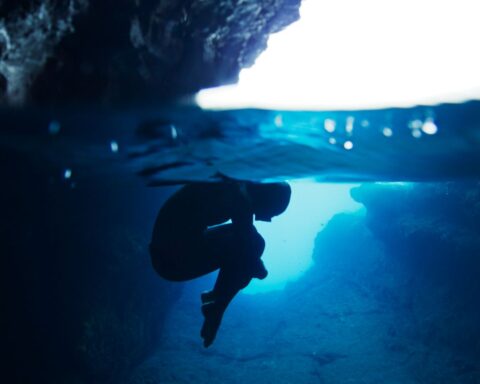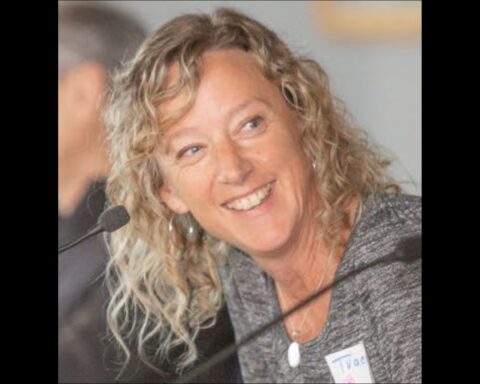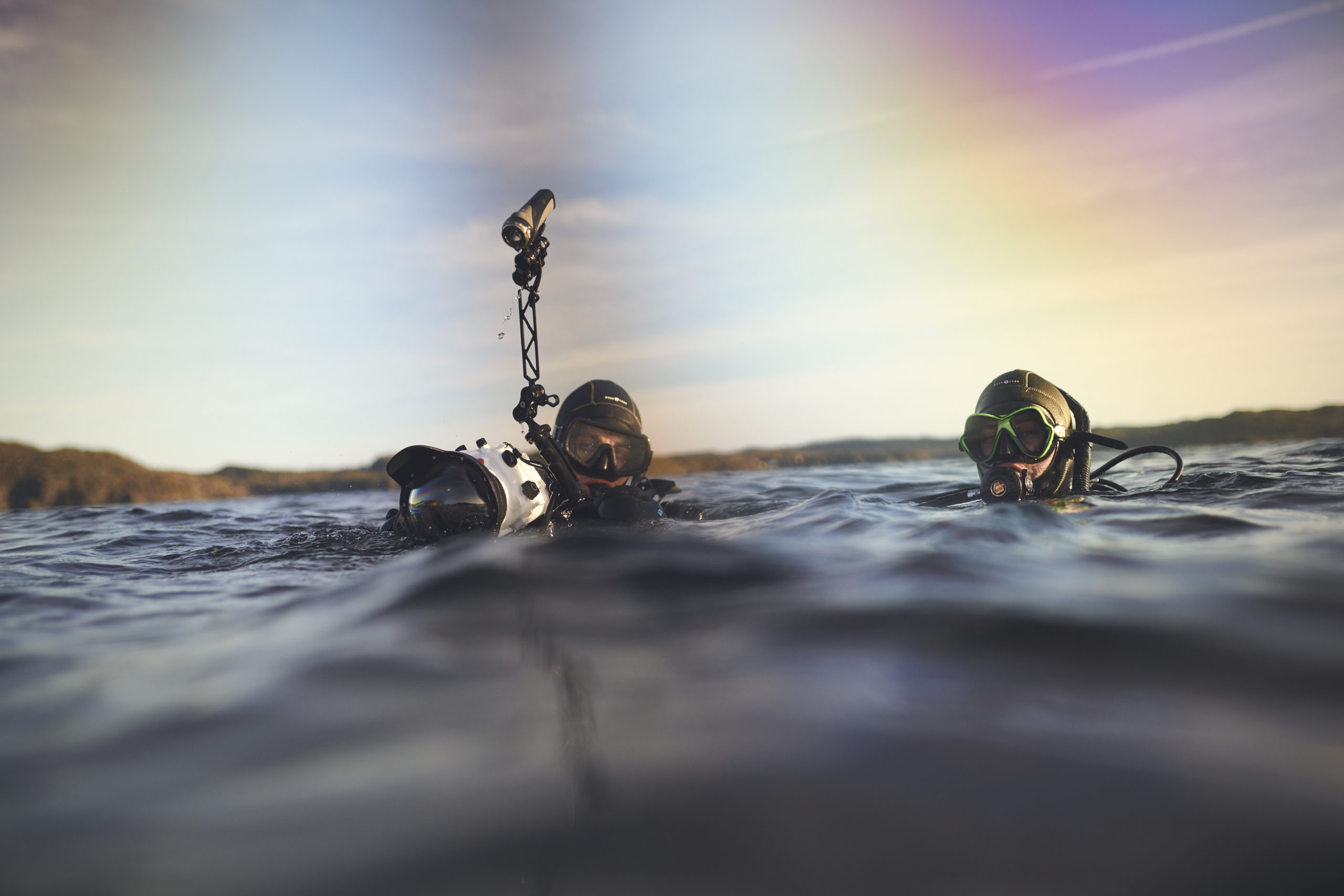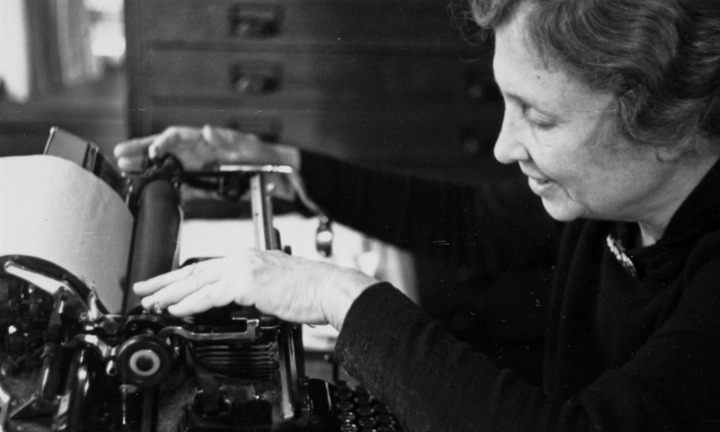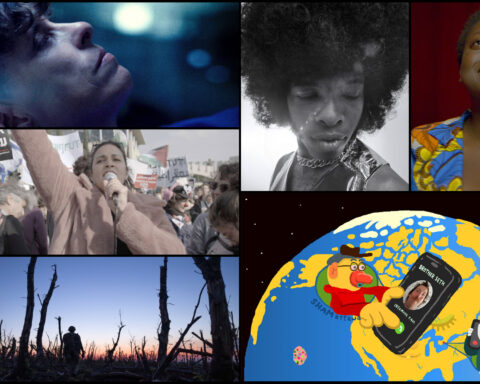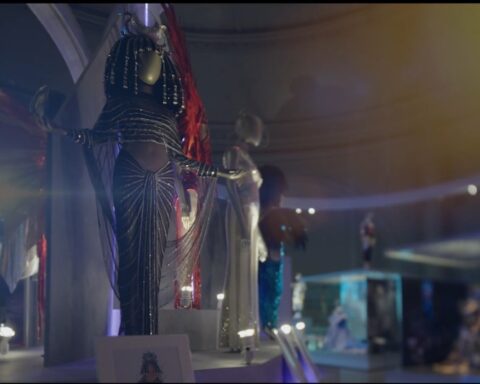The voice of Mary Two-Axe Earley rings clearly in a short doc that bears her name. Mary Two-Axe Earley: I Am Indian Again is director Courtney Montour’s portrait of the late Mohawk activist who boldly fought to amend portions of the Indian Act that revoked a woman’s Indigenous status if she married a non-status husband. The film draws upon a significant collection of audio interviews that legendary Abenaki filmmaker Alanis Obomsawin conducted with Earley at the activist’s kitchen table in Kahnawà:ke. Montour lets Earley be the authority on her own experience, using the words that Obomsawin carefully preserved when many archives in Canada wouldn’t make room for her story.
Earley’s voice is the backbone of the film, but Montour brings her own voice, as well as those of people who fought alongside Earley, like late Cree activist Nellie Carlson, into the dialogue between past and present. The film offers a deft collage that layers past and present allowing rare archival materials to evoke history that endures in the spirit of women who continue Mary Two-Axe Earley’s fight today. Montour previously chronicled her extensive quest for archival material in blogs for the NFB, which you can read here and here, and the process included an open call soliciting images. The film bears this effort, as Montour’s campaign yielded all sorts of finds, including footage of Earley at the National Action Committee on the Status of Women captured on obsolete U-matic ¾ inch video cassettes. More significantly, Montour recalls the stories that poured from across Canada.
Montour brings the conversation back to Earley’s kitchen table as she revisits the recordings with Mary’s son, Edward Early (whose named was misspelled on his birth certificate), and Cree-Mohawk educator Jodi Calahoo-Stonehouse and her daughter Isabella. The film lets Mary Two-Axe Earley’s legacy resonate within an ongoing struggle as the different generations consider the systemic inequities that govern Indigenous women in Canada. The director’s voice synthesizes the connection to Mary that many women conveyed through the journey as Montour speaks in voiceover to Earley, reflecting on her bravery and legacy. Montour’s film is deeply passionate as it gives a humble warrior her due.
POV spoke with Montour by phone ahead of the Hot Docs premiere of Mary Two-Axe Earley: I Am Indian Again.
POV: Pat Mullen
CM: Courtney Montour
This interview has been edited for brevity and clarity.
POV: What was the starting place for the film? Where did you discover the tapes while researching the film, or did hearing Alanis Obomsawin’s interviews with Mary Two-Axe Earley inspire the film?
CM: I’m from Kahnawà:ke, the same Mohawk community as Mary Two-Axe Earley. I grew up knowing who she was and seeing her name in newspapers whenever the issue of sex discrimination came up. I have always been very passionate about the issue of First Nations women and their children being excluded from our communities and seeing that hurt and that trauma. Alanis Obomsawin was mentoring Roxann Whitebean and me on our short film Flat Rocks, which was about the St. Lawrence Seaway and its impact on our community. That was back in 2017.
While we were working on that film, Alanis mentioned that she had these recordings of Mary. She’s so inspirational, so I knew I was going to make a film on her with these recordings. That was the basis even though a lot of my work deals with issues of Indigenous identity. I would never have accepted these recordings if I didn’t care about these issues.
I spent hours and hours just listening to Mary. Alanis’s audio recordings became the backbone of the film. This is Mary Two-Axe Earley’s film. It allows us her to tell her story, in her own words, in her own voice. She invites all of us into her kitchen and shares her story and fight with us.
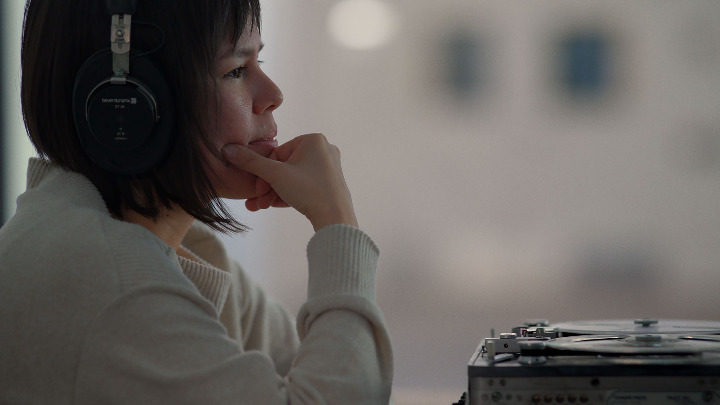
POV: Do you know why Alanis never used the tapes? Mary Two-Axe Earley seems like an ideal subject for her.
CM: At some point in the ’80s, someone else had intended to make a film on Mary. They had pitched the project and there was paperwork. Alanis is very graceful and never wants to step in the way of something that someone else is already starting. That was the reason why she didn’t do it, but the other film, for whatever reason, was never made
POV: What are some of the questions you might have asked Mary had you been able to interview her today?
CM: There are not really questions I would ask her. It speaks to the way we put together the film with the narration, giving us the effect that I’m speaking to her. I didn’t want to interfere with the experience of Mary sharing her story with us by adding informational narration. The way I speak to her and speak with her in the film, those are the things that I would say to her.
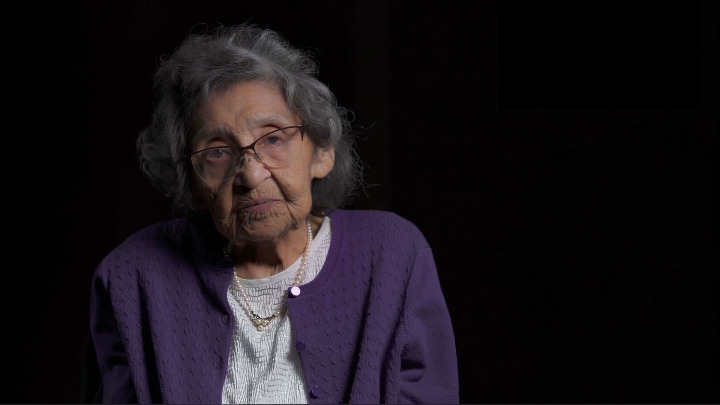
POV: There are two very distinct interview styles in the film: one is a more formal interview with Nellie Carlson, and the other is more of a casual conversation with Jodi Calahoo-Stonehouse, her daughter Isabella, and Mary’s son Ed around Mary’s kitchen table. What inspired the contrast?
CM: The film came together after a four-year journey. A big part of that is the lack of archives. I spent so much time traveling to different places—going to Edmonton, going to Ottawa—and speaking with as many people that knew Mary to try to see what still existed. Many times, I was tracking down things knowing the date that something happened, but there’d be no trace of images or photos. Mary Two-Axe Earley and these women, and their fight that went on for over two decades, was so well documented by the media at the time, but for some reason, it wasn’t kept or it’s completely mismanaged—buried and not labeled. It’s really upsetting to see how First Nations women’s stories are valued in this country. That [sentiment] guided the different filming that we did.
For Nellie Carlson, I sat with her when we were in the development stage. We didn’t know if we would be greenlit for production, but in 2017, I spoke with her and her family for several months over the phone, and I was heading to Edmonton to do some research. My producer at the National Film Board, Kat Baulu, understood that it was urgent to interview Nellie then because we didn’t know when we were going into production. [Carlson passed away in September 2020.] When I went to Edmonton, my director of photography Sylvaine Dufaux and I didn’t yet have a concept for how the film would look. We thought the best way to do this was with a simple setup with black background. Someone shot locally, because we didn’t know how we were going to incorporate it into the movie. For me, the most important thing was to hear Nellie, see Nellie, and have this important piece of history. So many of the women who worked alongside Mary have passed on and this history passes on with them.
POV: How did Jodi and Isabella come into the film?
CM: I met Jodi Calahoo-Stonehouse when I was in Edmonton back in 2017. For me, it was important to bring the present into this film. Sex discrimination against First Nations women in the Indian Act is so important because it’s ongoing. For people who don’t know the story, I didn’t want them to watch the film and think Mary’s story is only historical. No, it’s happening now.
I also wanted to find somebody from the Edmonton area because a lot of the women from Indian Rights for Indian Women were either based near Edmonton or in the Kahnawà:ke Montreal area. When I met Jodi and heard her story, I learned how she, her daughter, and her family were impacted by these laws. It was important to bring in these different generations. Being around the table was always very important to me because Mary’s house is such a historical place. It’s where she grew up, where she worked on this issue; her fight for First Nations women started in Kahnawà:ke.
These women worked around the kitchen table, so it made sense to go back there, especially because Alanis sat with Mary in her home and recorded her in 1984. It was the first time that that Jodi, Isabella, and Mary’s son Ed had heard these recordings. It was the first time that Jodi and Isabella heard Mary at all. It’s going to be the first time that many people hear Mary’s voice. Her name is mentioned, but many people of this generation have yet to hear her speak.
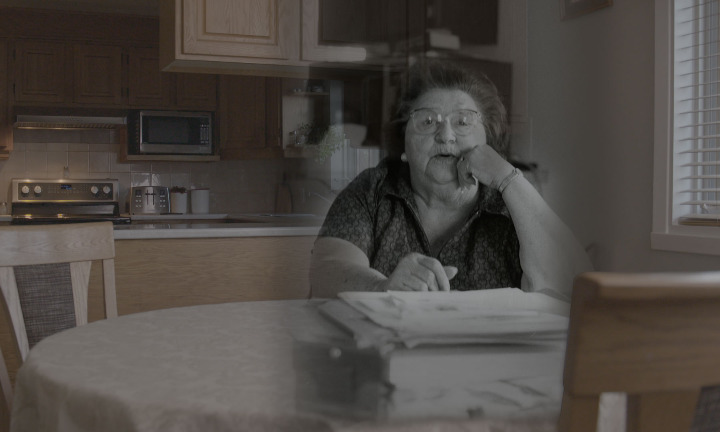
POV: When you’re sitting around the table, Jodi refers to the Indian Act as a “genocidal act.” Why is it important for audiences to understand this kind of policy within the concept of genocide, especially since the use of the term was quite controversial in the report on missing and murdered Indigenous women and girls, but eventually opened a deeper conversation about what genocide means?
CM: The biggest problem is that it is ongoing. Canada controls Indian status. It’s a sexist and racist way of defining who is Indian. That impacts us today. You mentioned missing and murdered Indigenous women and how sex discrimination in the Indian act is considered a root cause. But the government hasn’t released a plan to start working on this issue. [Montour noted that her usage of the term Indian reflects the language that continues to be used to this day while identifying and characterizing First Nations and Indigenous communities in the Indian Act.]
It impacts identity and whether we’re allowed to be in our home communities. That is an important part of understanding why we have the missing and murdered Indigenous women. If Indian status is key to belonging to a community, if you can’t live in a community, if you can’t vote in your community’s governments, and if you can’t serve on various boards, it takes away the ability to engage and be an active part of a community. It also takes away access to critical programs, like cultural and language resources are often tied to status. It really is a way to separate First Nations women and children from their communities and from their culture. That’s why Mary’s work is so important. It’s a reminder that this is ongoing. She took on Canada and it was a start, but what does that get us now? The sexism and racism in the Indian Act still exists. Thousands of women are still not registered. Their cases are in the courts, and they haven’t been compensated. There are provisions in the amendments that women can’t be compensated for this injustice, unlike other groups that can if their rights are violated in the charter. Institutional racist policies still exist and impact these women today. These amendments are still rooted in sexism and racism.
POV: There’s a moment in the archival footage when Pierre-Elliott Trudeau makes an incredibly tone deaf comment in the hearings, “If you think of yourself unequally, the laws won’t change much,” which you repeat. Why rewind that moment?
CM: It is so telling of what’s happening today. Even after multiple governments and changes in government, it’s the same sort of talk. It’s that paternalistic outlook. Hopefully by seeing the film on Mary Two-Axe Earley, her story will remind us of the achievements of First Nations women in Canada and the work they’ve done to push back against the Canadian government. Things are changing slowly. Mary did this in such a persistent but patient way—so caringly, lovingly, and compassionately for the women around her. Indigenous women are still doing the same thing and it’s time that these stories and their names are known by the public.
Mary Two-Axe Earley: I Am Indian Again screens at Hot Docs 2021, including a master class discussion Thursday, May 6, at 5:00 p.m. ET with Courtney Montour and Dr. Pamela Palmater.




